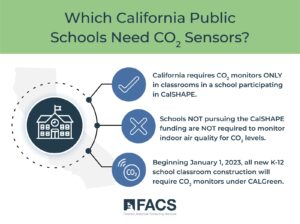In January of 2021, the California Division of the State Architect issued Bulletin IR N-2 stating that “As of January 1, 2021, all existing classrooms must be equipped with a carbon dioxide (CO2) monitoring device meeting all of Section 1625.”
The Section 1625 reference is to the California Public Utilities Code (PUC) Article 3, Chapter 6.7, the “School Reopening Ventilation and Energy Efficiency Verification and Repair Program.”
Those two documents understandably stirred up a whirl of controversy: Are all California K-12 classrooms now required to install CO2 monitors?
First glance at the issue would confirm the immediate necessity for monitors in all classrooms as absolutely true . . . but it’s not. Here’s why.

Background of California’s School Energy Efficiency Stimulus Program
To maintain healthy indoor environmental quality, especially during the COVID pandemic, the optimization of ventilation in buildings is deemed paramount. Since people exhale carbon dioxide, levels of CO2 are often used to measure how well spaces are being ventilated. High CO2 levels indicate the need for additional airflow.
In September of 2020, California’s governor authorized the School Energy Efficiency Stimulus Program (SEES) “to fund critical school improvements, support efforts to reopen schools consistent with COVID-19 guidance, and provide jobs.” That act provides grant money for schools to upgrade their HVAC systems. To get the grant money, upgrades are required to meet several requirements, one of which is to install CO2 sensors in every classroom.
Given the PUC bulletin and language in the code already mentioned, many school administrators and other stakeholders believe they need to install CO2 sensors to meet the code — regardless of whether or not the school applied for grant funding. That is an understandable, but erroneous belief.
Which California Public Schools Need CO2 Sensors Now?
The SEES program is now known as the California Schools Healthy Air, Plumbing, and Efficiency Program (CalSHAPE). On June 21, 2021, the California Division of the State Architect amended the earlier language by issuing Bulletin BU 21-02. The new requirement reads as follows:
Per PUC 1625, participation in the CalSHAPE Program also requires the installation of carbon dioxide (CO2) monitoring devices in all classrooms, either hard-wired or plugged into an electrical outlet. Plans submitted to DSA that include CO2 monitors will be reviewed for compliance with PUC 1625 and applicable accessibility requirements if (CO2) monitoring devices in the classroom require operation by teachers.
In other words, California currently requires CO2 monitoring ONLY for classrooms in a school participating in CALShape. Schools not receiving the CALShape grant money are NOT required to monitor indoor air quality for CO2 levels. But that will soon change, too.
CO2 Monitoring for Schools Under CALGreen
FACS asked the California Division of State Architect for clarification. They responded as follows:
Presently, the CO2 monitors in classrooms apply to only those projects seeking funding under CALShape (formerly the School Energy Efficiency Stimulus (SEES) Program). Beginning January 1, 2023, with the effective date of the 2022 CALGreen, all K-12 school projects of new construction with classrooms will also require CO2 monitors.
Accordingly, current requirements affect only those schools participating in CALShape. Beginning in 2023, however, all new K-12 school classroom construction will require CO2 monitoring under CALGreen, according to the state architect.
Given the changes already observed in California law pertaining to this topic, FACS advises those planning school construction projects in 2023 to monitor the development of CALGreen.
For now, while CO2 monitoring in classrooms is advised, monitors are required only for CALShape participants. If you’re concerned about CO2 levels in your current classrooms, call FACS at (888) 711-9998 for an onsite inspection.